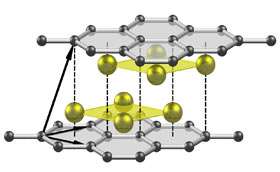New 'metal sandwich' may break superconductor record

After an exhaustive data search for new compounds, researchers at Duke University's Pratt School of Engineering have discovered a theoretical "metal sandwich" that is expected to be a good superconductor. Superconductive materials have no resistance to the flow of electric current.
The new lithium monoboride (LiB) compound is a "binary alloy" consisting of two layers of boron -- the "bread" of the atomic sandwich -- with lithium metal "filling" in between, the researchers said. Once the material is synthesized, it should be superconductive at a higher temperature than other superconductors in its class, according to their results.
The researchers reported their findings in the May 5 online edition of the journal Physical Review B, Rapid Communications.
"To the best of our knowledge, this alloy structure had not been considered before," said Stefano Curtarolo, professor of mechanical engineering and materials sciences at Duke's Pratt School. "We have been able to identify synthesis conditions under which the LiB compound should form. And we believe that if the material can be synthesized, it should superconduct at a higher temperature, perhaps more than 10 percent greater, than any other binary alloy superconductor."
"The significance of the work is not only the discovery of lithium monoboride itself, but also that this opens the door to finding derivatives that could aid in the search for additional novel superconductors," added Aleksey Kolmogorov, lead author of the study and a postdoctoral fellow at the Pratt School. He said that once a new superconductive material is identified, scientists typically can manipulate the substance -- twisting it or doping it with other elements – to create related structures that might have even more appealing properties.
Superconductors have the potential to produce more efficient electronics and electric generators, according to the researchers. The materials also have unique magnetic capabilities that may enable their use in transportation applications, such as "levitated" trains that glide over their tracks with virtually no friction.
However, today's superconductors perform only when cooled to extremely low temperatures near absolute zero, which is -459.67 degrees Fahrenheit, or 0 degrees Kelvin. This requirement makes their use prohibitively expensive, the researchers said.
The first superconductive material was identified in 1911 when a Dutch scientist cooled mercury to 4 degrees Kelvin, the temperature of liquid helium. Since then, scientists have discovered superconductivity in various materials, including other pure elements, complex ceramics, and binary alloys.
Since 1986, ceramics have held the overall record for highest superconducting temperature -- currently 138 degrees Kelvin. Among pure elements, lithium, when contained under pressure, holds the record at 20 degrees Kelvin.
Recently, scientists scored an unexpected breakthrough with the discovery of superconductivity in the simple binary alloy magnesium diboride (MgB2), Curtarolo said. This compound holds the current temperature record for its class at 39 degrees Kelvin, and it has attracted much attention because it can be produced relatively easily from two abundant elements.
"The physics of the superconductivity in MgB2 is now well understood," Kolmogorov said. "However, MgB2 has been shown to be such a unique superconductor -- finely tuned by nature -- that attempts to improve it or use it as a model for finding even better superconducting materials have so far been fruitless."
Curtarolo and Kolmogorov decided it was time to try something else. Using a theoretical data-mining method developed by Curtarolo, the pair scoured a database of experimental and hypothetical compounds, looking for other possible configurations of binary alloys and tweaking their compositions.
In the process, the team stumbled onto "a path to a new metal sandwich structure consisting of stacks of metal and boron layers," Curtarolo said.
Additional calculations identified the binary alloy lithium monoboride as a promising candidate that might be both structurally stable and superconductive at temperatures that exceed those of the current binary alloy record-holder.
"It's a very thin line, because as you try to increase the temperature at which a material becomes superconducting, the material tends to lose its stability," Kolmogorov said. "But we think lithium monoboride should be stable and superconduct at temperatures greater than 39 degrees Kelvin."
"It was like spotting a $100 bill on the street," Curtarolo said of the finding. "It seemed impossible that this could be real and that no one had seen it before."
The researchers are now conducting more precise theoretical calculations of LiB's "critical temperature" -- that is, the temperature at which it becomes superconductive -- with computational support from the San Diego Supercomputer Center at the University of California, San Diego.
The material will have to be synthesized before experimental tests can confirm any of the theoretical results, the researchers said. They added that this won't be an easy process, as manufacturing lithium monoboride will require extremely high temperatures and pressures.
Source: Duke University





















